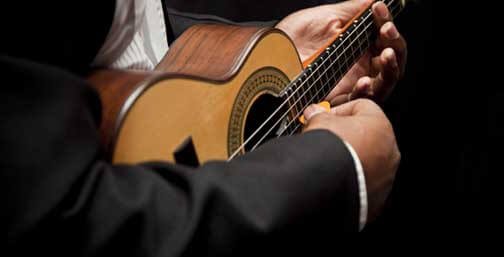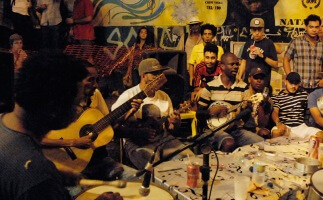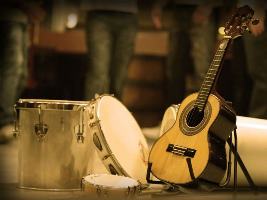Blog
History and Types of Samba in Brazil

Samba is a Brazilian dance and music genre that originated among the Afro-Brazilian communities in Bahia. However, its true development occurred in Rio de Janeiro during the 19th century. Samba in Brazil is one of the main elements of Brazilian culture. It is part of the daily life of its people and recognized by UNESCO as an Intangible Cultural Heritage of Humanity.
Table of Contents
ToggleHistory of Samba in Brazil
Samba has its origins with the African slaves in Brazil. They started to mix their beats with European rhythms, like polka and waltz. The slaves used to play their instruments, sing, and dance in a circle, creating Samba de Roda. However, by that time, these kinds of beats were much more intimately tied with religious celebrations and rituals than entertainment itself.
 Historians say Samba originated in Bahia, but strengthened in Rio de Janeiro in the 19th century when Rio became the capital of the Portuguese Empire. However, just like Capoeira, Afro-Brazilian religions, and any other type of African expression, Samba was not seen with good eyes. Because of that, musicians and Samba lovers started to hide in people’s homes to celebrate their music. That was when the music genre started to develop around the slums of the city center, especially in the Candomblé temples.
Historians say Samba originated in Bahia, but strengthened in Rio de Janeiro in the 19th century when Rio became the capital of the Portuguese Empire. However, just like Capoeira, Afro-Brazilian religions, and any other type of African expression, Samba was not seen with good eyes. Because of that, musicians and Samba lovers started to hide in people’s homes to celebrate their music. That was when the music genre started to develop around the slums of the city center, especially in the Candomblé temples.
Important names of Samba in Brazil like Pixinguinha, Heitor dos Prazeres, and Donga got involved with these events back then. Famous journalists and authors also started to attend the parties as well, such as Francisco Guimarães, Manuel Bandeira, and Mário de Andrade.
By the end of the 19th century, samba started to grow among the slums of Rio and the general population, establishing itself as a musical genre.
From the 1930s onwards, samba found space with the phonographic industry and radio. By then, people were also relating Samba with Carnival and ballroom parties. That is when Samba became one of the main elements of Brazilian culture.
Types of Samba in Brazil
Samba-Canção
With a slower pace and romantic lyrics, it often sings about loneliness, love, and relationships.
Samba de Breque
This style uses sudden stops in the song to which the singer adds personal comments, usually with a critical or humorous tone.
Samba de Gafieira
A ballroom dance type of Samba. It is influenced by maxixe music, in which dancers explore rhythm and sensuality.
Samba de Partido Alto
This subgenre sings about the reality of the slums and unprivileged people of Brazil.
Samba de Roda
It is one of the most traditional types of samba in Brazil. The National Historical and Artistic Heritage Institute (IPHAN) considers Samba de Roda an Intangible Heritage of Brazilian Culture.
Singing, clapping, and playing musical instruments around a circle strongly characterizes Samba de Roda. Moreover, lots of dancing also occur around the musicians.
Samba-Enredo
Samba-enredo has its origins during the ’50s and it is strongly linked to Carnival. Samba schools use this subgenre to tell the story of the theme chosen as the plot of their parade.
Samba Exaltação
Patriotism is the main theme of this subgenre. Usually accompanied by an orchestra, their lyrics exalt the beauties of Brazil.
Sambalanço
A very lively and dancing type of samba originated in the ’50s, influenced by jazz and Caribbean rhythms.
Pagode
Born in Rio de Janeiro in the ’70s, Pagode uses repetitive rhythm, percussion instruments, and electronic beats. It quickly spread throughout Brazil, thanks to lively and romantic lyrics.
Instruments Used in Samba
 cavaquinho — a small four-stringed guitar
cavaquinho — a small four-stringed guitar- cuíca — a friction drum
- pandeiro — a hand frame drum
- reco-reco — a scraper used as a percussion instrument
- surdo — a bass drum
- tamborim — the tambourine
- tan-tan — a hand drum
- violão — the acoustic guitar
At Caminhos, you will learn how to speak Brazilian Portuguese in an effective, dynamic, and fun way. We offer you a diverse learning curriculum and cultural immersion in Rio de Janeiro. Small group classes facilitate student-teacher interaction.


 Deutsch
Deutsch Français
Français Português
Português Español
Español


Excelente informação!!!